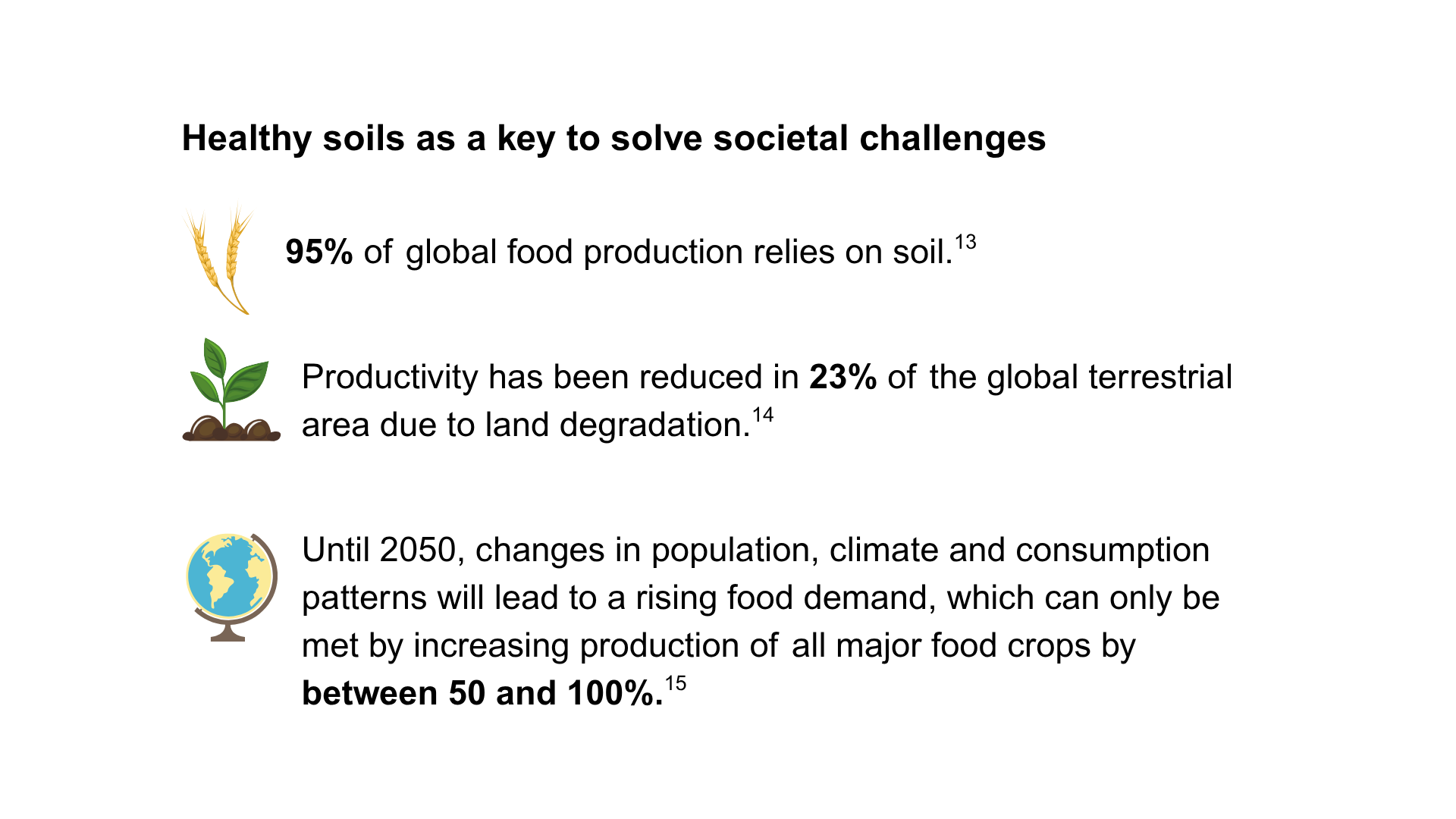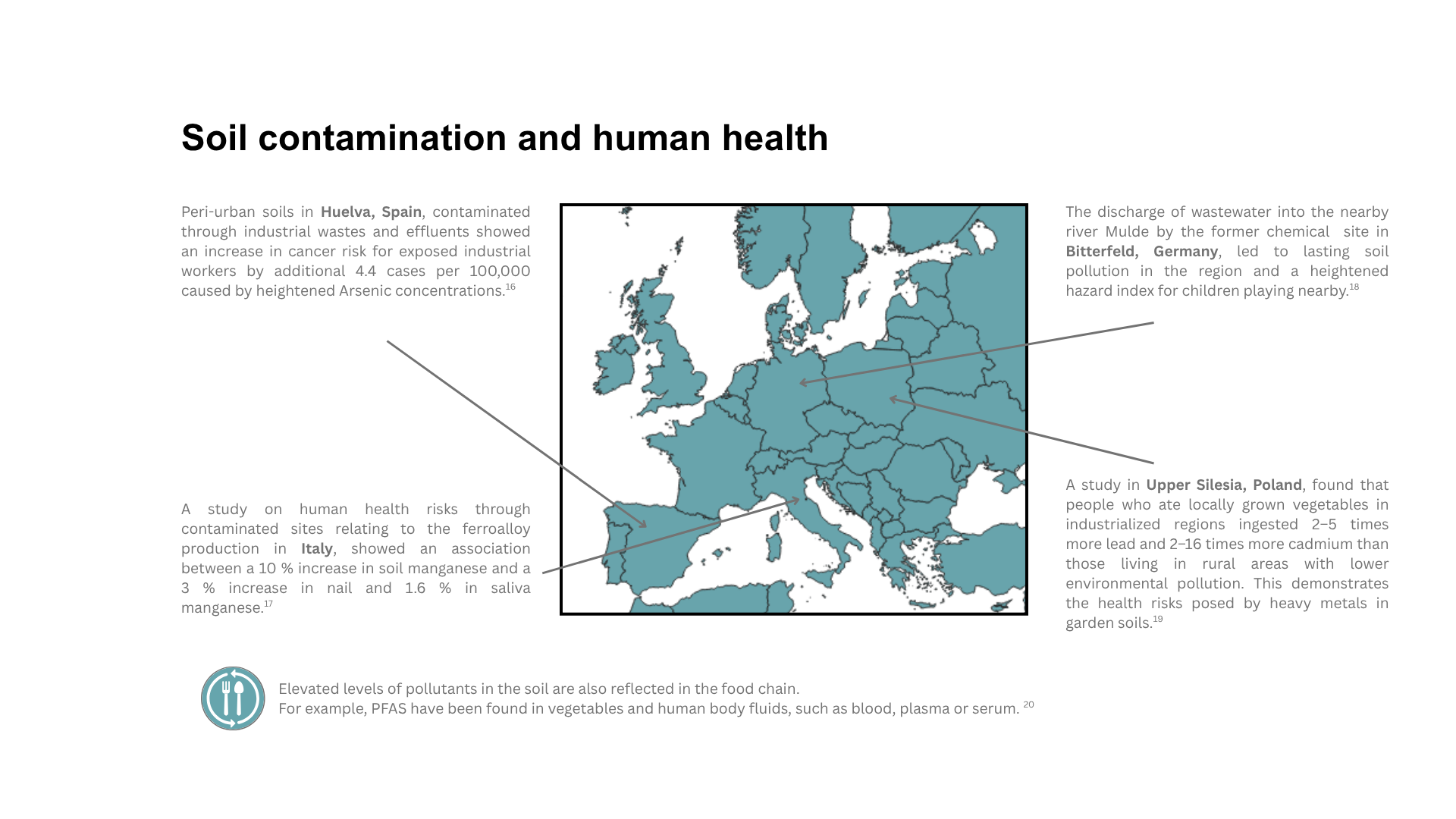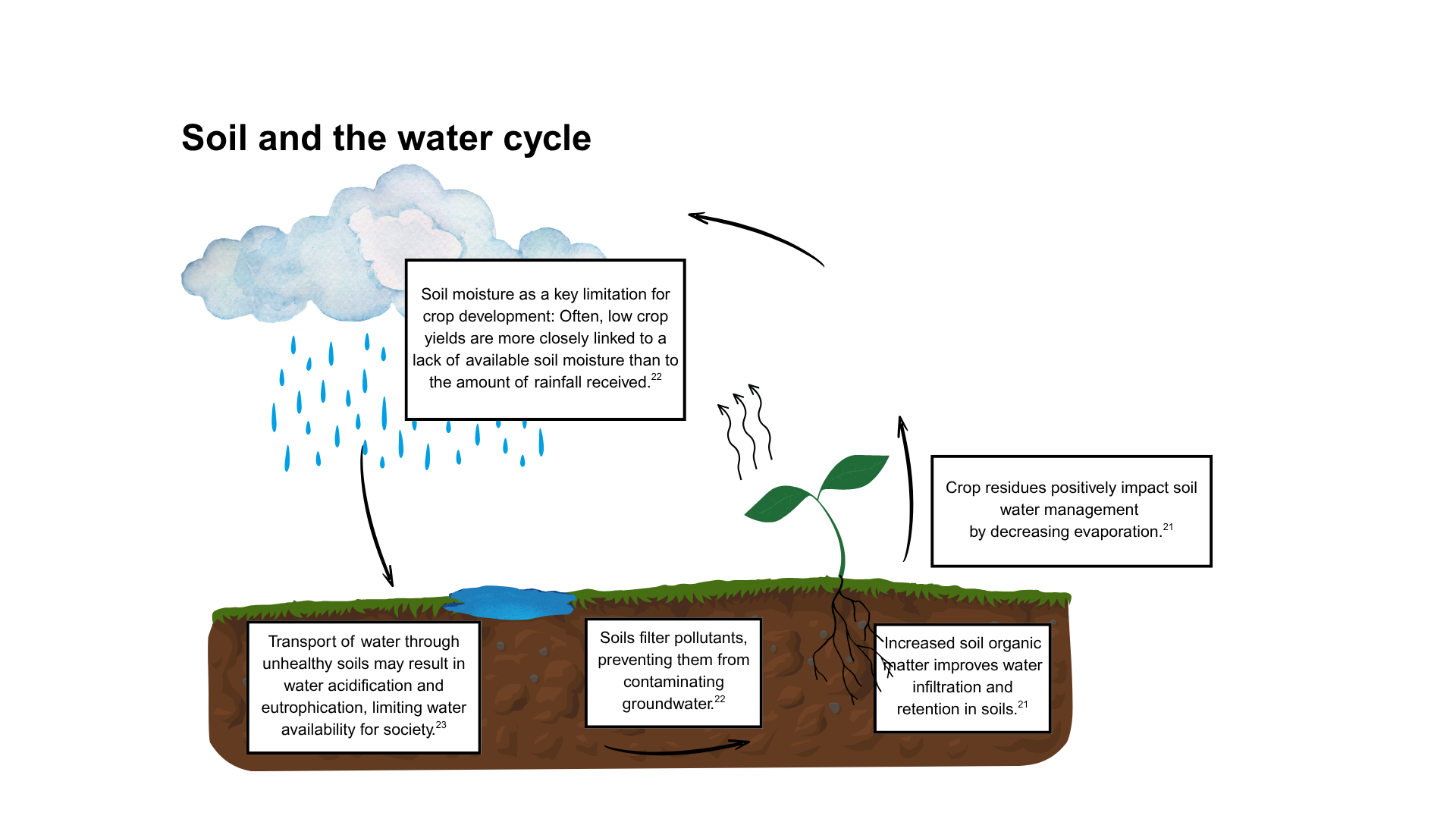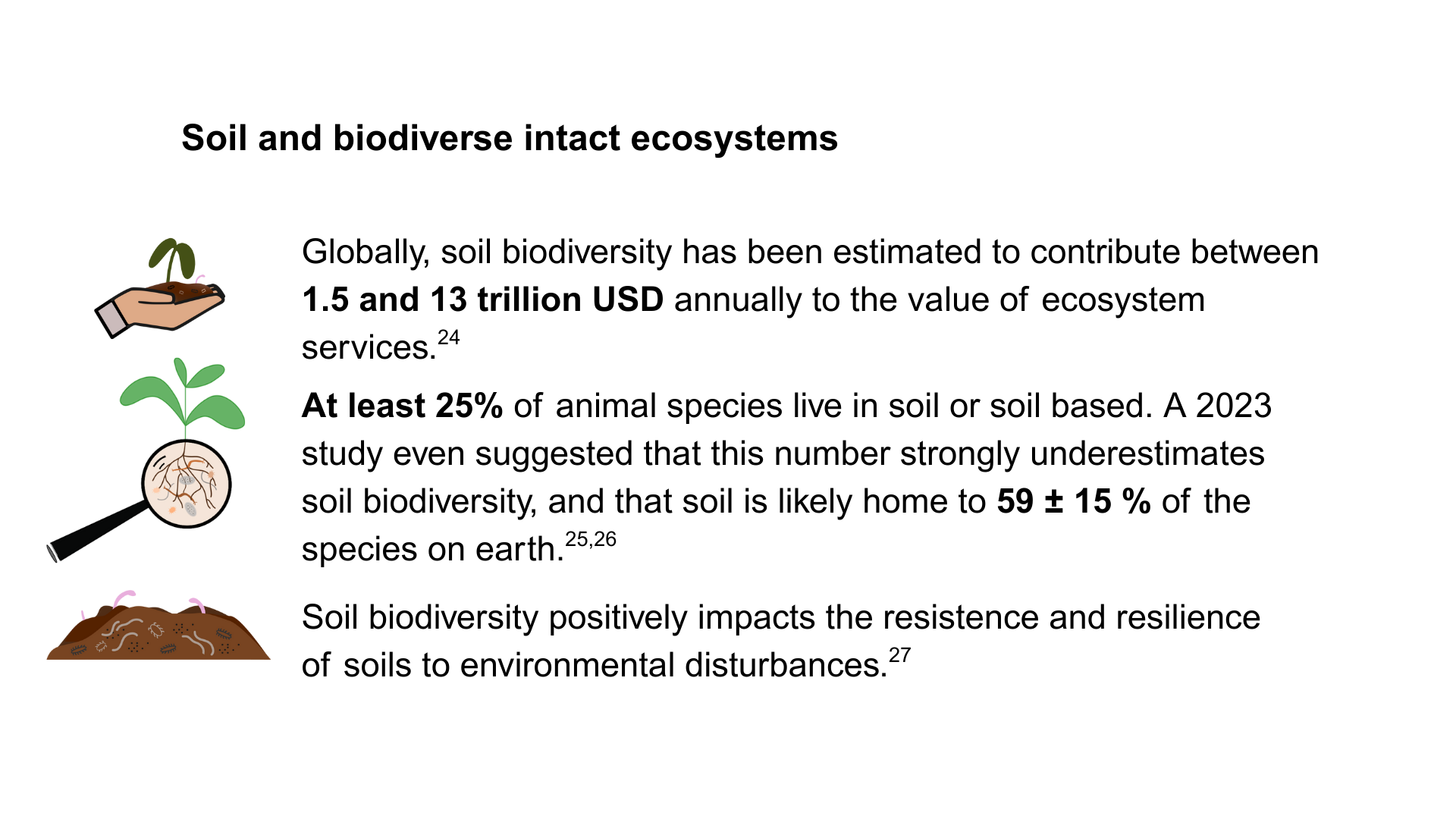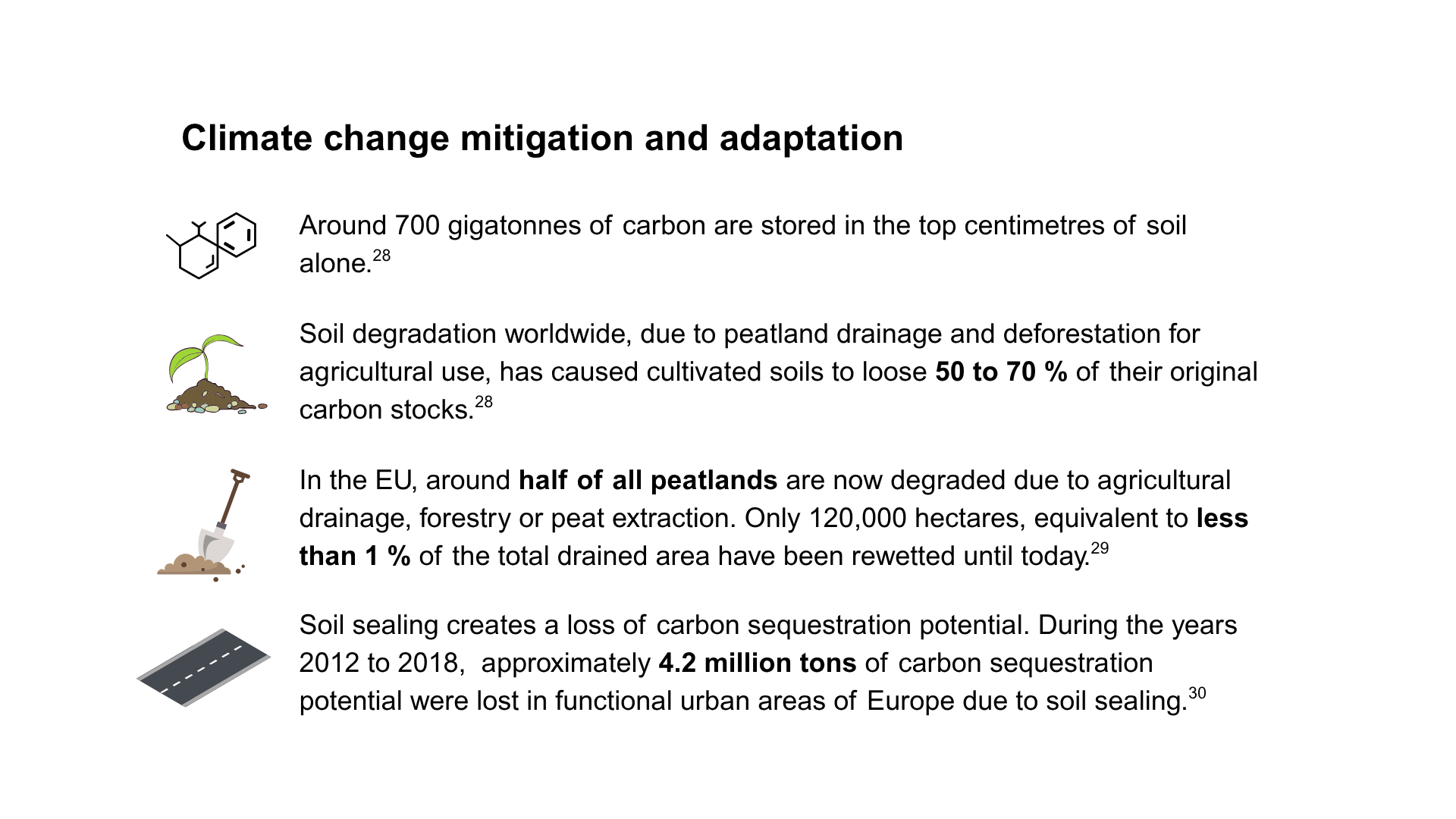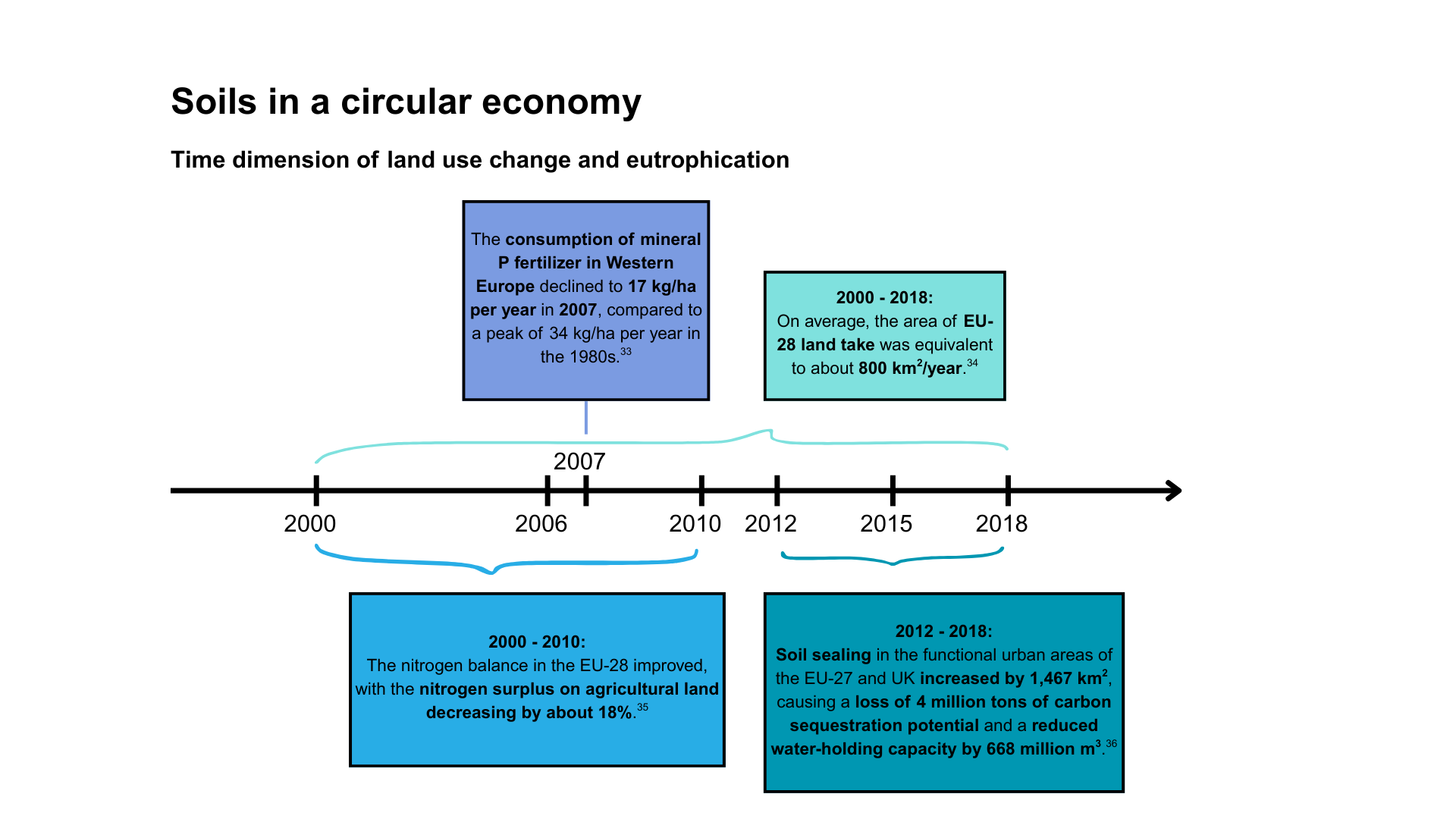Key Facts on Soil Health
We depend on healthy soils for many reasons, including food, water quality, climate change mitigation and biodiversity.1 Soils are fundamental to food production, supporting approximately 95% of global food crops. They also act as a natural filter for water, helping to maintain clean and reliable water supplies.2 Moreover, soils store more carbon than the atmosphere and all plant life combined, playing a crucial role in mitigating climate change.3 The condition of our soils influences human health in both direct and indirect ways.1 Unfortunately, due to unsustainable practices, many soils worldwide are degrading and in poor conditions.4 This threatens food security, water quality, and biodiversity, requiring urgent global action to restore and protect this vital resource.5
- At least 25%
of global biodiversity lives in the soil - more species than in any other ecosystem6
- 98%
of the world’s food is produced by arable soils, despite their limited areal extent7
- 1/3
of global land area used for agricultural land and forestry each8
- 10.5%
of agricultural land in the European Union was farmed organically in 20229
- 157 main soil types
in Europe (excluding urban soils, intergrades, associations and local variants)10
- 29 out of 83
global ecosystem services are directly affected by soil health and 40 additional ecosystem services are impacted in relation to agricultural soil management11
- 62%
of soils affected by degradation processes or soil sealing12
- 89%
of Agricultural soils show signs of degradation beyond generic sustainable target values12
Introduction
1 Steffan, J.J. et al. (2017b) 'The effect of soil on human health: an overview', European Journal of Soil Science, 69(1), pp. 159–171. https://doi.org/10.1111/ejss.12451.
2 Food and Agriculture Organization of the United Nations (FAO) (2021) The State of the World's Land and Water Resources for Land and Water Resources for Food and Agriculture: Systems at breaking point. Available at: https://openknowledge.fao.org/server/api/core/bitstreams/ecb51a59-ac4d-407a-80de-c7d6c3e15fcc/content (Accessed: 15 June 2025).
3 Food and Agriculture Organization of the United Nations (FAO) and Intergovernmental Technical Panel on Soils (ITPS) (2015) Status of the World's Soil Resources (SWSR) - Main Report. Rome, Italy. FAO. Available at: https://openknowledge.fao.org/server/api/core/bitstreams/6ec24d75-19bd-4f1f-b1c5-5becf50d0871/content(Accessed: 15 June 2025).
4 Gomiero, T. (2016) 'Soil degradation, land scarcity and food Security: Reviewing a complex challenge', Sustainability, 8(3), p. 281. https://doi.org/10.3390/su8030281.
5 United Nations News (2014) UN agency calls for urgent action to protect global soil from depletion, degradation. Available at: https://news.un.org/en/story/2014/07/473762(Accessed: 15 June 2025).
Key facts:
6 Decaëns, T. et al. (2006) 'The values of soil animals for conservation biology', European Journal of Soil Biology, 42(1), pp. 23–S38. https://doi.org/10.1016/j.ejsobi.2006.07.001.
7 Katyal, J.C., Datta, S. & Golui, D. (2016) 'Global review on state of soil health', Indian Society of Soil Science, 30, pp. 1-33. Available at: https://www.researchgate.net/profile/Debasis-Golui/publication/307539481_Global_Review_on_State_of_Soil_Health/links/57c7b06b08ae9d64047ea519/Global-Review-on-State-of-Soil-Health.pdf#page=10 (Accessed: 08 June 2025).
8 FAO (2024) 'Land statistics 2001–2022 – Global, regional and country trends (FAOSTAT Analytical Briefs, No. 88)', Rome. https://doi.org/10.4060/cd1484en.
9 European Environment Agency (2024, November 19) Agricultural area under organic farming in Europe. Available at: https://www.eea.europa.eu/en/analysis/indicators/agricultural-area-used-for-organic?utm_source (Accessed: 08 June 2025)
10European Soil Bureau Network, European Commission (2005) Soil Atlas of Europe, Office for Official Publications of the European Communities, L-2995 Luxembourg. ISBN 92-894-8120-X.
11 Paul, C. et al. (2020) 'Towards a standardization of soil‐related ecosystem service assessments,' European Journal of Soil Science, 72(4), pp. 1543–1558.https://doi.org/10.1111/ejss.13022.
12 European Commission (2025) EUSO Soil Degradation Dashboard. Available at:https://esdac.jrc.ec.europa.eu/esdacviewer/euso-dashboard/ (Accessed: 08 June 2025).
Healthy soils as a key to solve societal challenges
13EUROSTAT (2025, June) Land use statistics. Available at: https://ec.europa.eu/eurostat/statistics-explained/index.php?title=Land_use_statistics (Accessed: 21.08.25).
14 Heinrich-Böll-Stiftung and TMG - Think Tank for Sustainability (November 2024) Soil Atlas 2024, 1st edition, ISBN: 978-9-46494422-8.
15 The Royal Society (2009) Reaping the benefits: science and the sustainable intensification of global agriculture. Available at: https://royalsociety.org/-/media/policy/publications/2009/4294967719.pdf (Accessed: 10 June 2015).
Soil contamination and human health
16 Fernández-Caliani, J. C., González, I., & Romero, A. (2012) 'Risk-based assessment of multimetallic soil pollution in the industrialized peri-urban area of Huelva, Spain', Environmental Geochemistry and Health, 34(1), pp. 123–139. https://doi.org/10.1007/s10653-011-9396-0.
17 Butler, L. et al. (2018) 'Assessing the contributions of metals in environmental media to exposure biomarkers in a region of ferroalloy industry', Journal of Exposure Science & Environmental Epidemiology, 29(5), pp. 674–687. https://doi.org/10.1038/s41370-018-0081-6.
18 Brack, W. et al. (2002) 'Hochwasser 2002: Chemische und toxische Belastung überschwemmter Gemeinden im Raum Bitterfeld', Umweltwissenschaften Und Schadstoff-Forschung, 14(4), pp. 213–220. https://doi.org/10.1065/uwsf2002.10.049.
19 Gzyl, J. (1990) 'Lead and cadmium contamination of soil and vegetables in the upper silesia region of Poland', Science of The Total Environment, 96(1-2),pp.199-209.
https://doi.org/10.1016/0048-9697(90)90018-P.
20 Sunderland, E. M. et al. (2018) 'A review of the pathways of human exposure to poly- and perfluoroalkyl substances (PFASs) and present understanding of health effects', Journal of Exposure Science & Environmental Epidemiology, 29(2), pp. 131–147. https://doi.org/10.1038/s41370-018-0094-1.
Soil and the water cycle
21 Reicosky, D.C. (2005) ‘Conservation agriculture: Zero tillage impact on soil organic matter. 27th Annual Zero Tillage and Winter Wheat Workshop’, Manitoba-North Dakota Zero Tillage Farmers Association, pp. 39-47. Available at: https://www.ars.usda.gov/ARSUserFiles/50600000/Products-Reprints/2005/1229.pdf (Accessed: 20 June 2025).
22 FAO (2015, August 27) Soils in the water cycle. Available at: https://www.fao.org/soils-2015/news/news-detail/pt/c/326283/ (Accessed: 20 June 2025).
23 FAO and UNEP (2021) 'Ecosystems impairment caused by soil pollution (Chapter 4.2)', in: Global assessment of soil pollution: Report. Rome. https://doi.org/10.4060/cb4894en.
Soil and biodiverse intact ecosystems
24 European Commission (n.d.) Soil biodiversity, European Soil Data Centre (ESDAC). Available at: https://esdac.jrc.ec.europa.eu/themes/soil-biodiversity (Accessed: 08 July 2025).
25 Decaëns, T. et al. (2006) 'The values of soil animals for conservation biology', European Journal of Soil Biology, 42(1), pp. 23-38. https://doi.org/10.1016/j.ejsobi.2006.07.001.
26 Anthony, M.A., Bender, S.F. , van der Heijden, M.G.A. (2023) ‘Enumerating soil biodiversity’, Proceedings of the National Academy of Sciences., pp. 120(33). https://doi.org/10.1073/pnas.2304663120.
27 Jeffery, S.et al. (2010) European Atlas of Soil Biodiversity, European Commission, Publications Office of the European Union, Luxembourg. Available at: https://esdac.jrc.ec.europa.eu/Library/Maps/Biodiversity_Atlas/Documents/Biodiversity_Atlas.pdf (Accessed: 10 July 2025).
Soil and climate change mitigation and adaptation
28Joint Research Centre (2025, 18 March) Soil oganic carbon is at risk in a large part of European agricultural land. Available at: joint-research-centre.ec.europa.eu/jrc-news-and-updates/soil-organic-carbon-risk-large-part-european-agricultural-land-2025-03-18_en (Accessed: 12 August 2025).
29 Lugato, E. et al. (2013) 'A new baseline of organic carbon stock in European agricultural soils using a modelling approach', Global Change Biology, 20(1), pp. 313-326. doi.org/10.1111/gcb.12292.
30Jobbágy, E.G., Jackson, R.B. (2000) 'The vertical distribution of soil organic carbon and its relation to climate and vegetation', Ecological Applications, 10(2), pp. 423-436. doi.org/10.1890/1051-0761.
31Anthony, M.A., Bender, S.F. , van der Heijden, M.G.A. (2023) 'Enumerating soil biodiversity', Proceedings of the National Academy of Sciences, pp. 120(33). doi.org/10.1073/pnas.2304663120.
32 Jeffery, S. et al. (2010) European Atlas of Soil Biodiversity, European Commission, Publications Office of the European Union, Luxembourg. Available at: esdac.jrc.ec.europa.eu/Library/Maps/Biodiversity_Atlas/Documents/Biodiversity_Atlas.pdf (Accessed: 10 July 2025).
Soils in a circular economy
33 Sattari, S.Z., et al. (2012) ‘Residual soil phosphorus as the missing piece in the global phosphorus crisis puzzle’, Proc. Natl. Acad. Sci., 209, pp. 6348-6353.
34 European Environment Agency (2019) Yearly land take and net land take in EU-28 and EEA-29 regions. Available at: https://www.eea.europa.eu/en/analysis/maps-and-charts/yearly-land-take-and-net?activeTab=570bee2d-1316-48cf-adde-4b640f92119b (Accessed: 21 July 2025).
35 European Environment Agency (2019) Agricultural land: nitrogen balance. 2018. Available at: https://www.eea.europa.eu/airs/2018/natural-capital/agricultural-land-nitrogen-balance (Accessed: 30 July 2025).
36 European Environment Agency (2021) ‘Land take and land degradation in functional urban areas’, EEA Report 17/2021. ISBN 978‑92‑9480‑465‑5.
Pictures:
© Julia von Guilleaume, Thuenen-Institute, 2025
